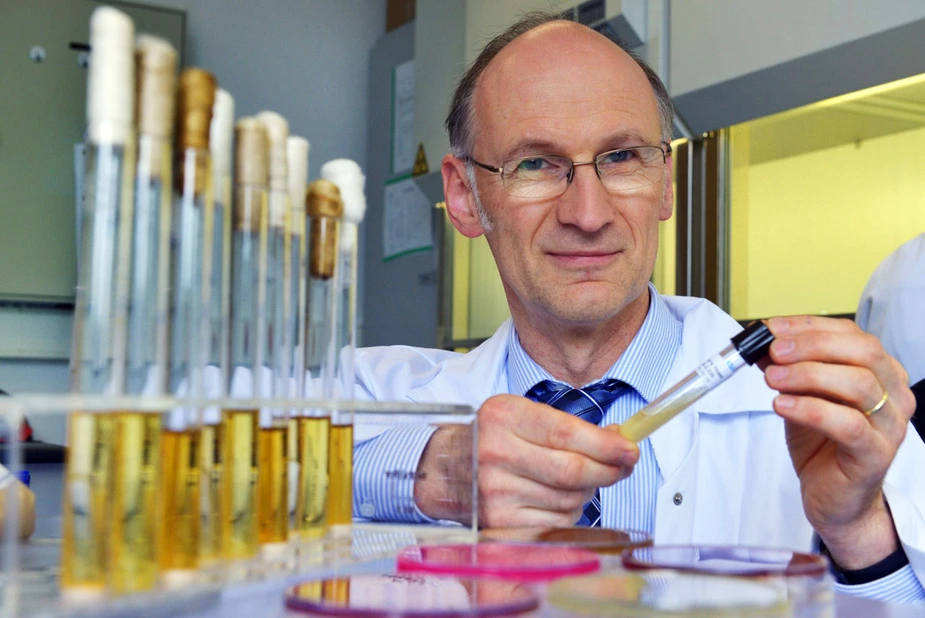The baker’s fuel
The stuff that makes our bread taste so good
Flour, sugar, a kneading machine: we are making dough in the lab. One ingredient with a very characteristic smell is essential: yeast. This fascinating organism is the main focus of the VH Berlin e.V. Research Institute for Baker's yeast, which moved from Moabit to Adlershof at the beginning of this year.
Yeast is with us every day: starting with our roll at breakfast, the vegetable broth in our lunch, and beer after work. It is a baking agent, a flavor enhancer, and a fermentation agent. Eight employees of research institute in Adlershof deal with yeast for baking. Consumers are familiar with it as an inconspicuous, beige coloured cube or, increasingly, as dry yeast, which is easier to use and has also proven easier to store.
Baking yeast is a living organism. Its scientific name, saccharomyces, translates to sugar fungus. The tiny single celled organisms’ digestion transforms sugar into alcohol and carbon dioxide, which ensures that dough rises and baked goods are finely pored. Additionally, about 80 other substances, so-called secondary yeast metabolites, including alcohols, ester, aldehydes, play an important role in the production of flavour: “The secret to a wealth of flavours is the exact time when yeasts are added to their synthesis,” as Dr. Michael Quantz tells us, who is head of the research laboratory.
“As the association of yeast producer’s institute, we offer quality control, statistics, process and product development,” explains Dr. Quantz. “And we conduct research in all these fields – often together with other research institutes.” The institute acts as a middle man between producers, suppliers, and other institutes. Customers from the industry come from all over the world. The association has 40 international members – France, Canada, China, and Turkey are among the largest producers of yeast. The number of production sites in Germany has shrunk from forty to four since the 1940s.
The association’s activities are as diverse as the laboratories it runs, for example, for analyzing the vitality of yeast cells or examining the mechanical properties of dough. The institute’s centerpiece is the pilot fermenter and applications laboratory facility for yeast production. “It serves to simulate the processes done by companies on a larger scale, including the commonly used ferment controlling technology,” says Quantz. “We also do that for training purposes.”
Yeast is the result of biotechnological process. First, the initial yeast is multiplied from a small amount of yeast starters by feeding them with a growth media. Molasses, which is a partly de-sugared by-product from sugar production, has established itself as the main carbohydrate for this. They key process takes place in industrial yeast fermenters, which hold up to 200 cubic metres. Inside, adding molasses and nitrogen as well as ventilation with filtered air produces yeast biomass. This is process is controlled very carefully in order to gain as much biomass with as little alcohol as possible. After 16 hours the yeast mass has increased eightfold.
It is then washed and cleaned from molasses residual products and salts, and then dehydrated, pressed into shape, and dried, if required. The utmost concern here is purity. The institute’s most important task is quality control for yeast producers and users from the baking industry. Michael Quantz and his team analyse the ingredients for this process very closely: depending on their intended use, yeast strains are examined whether they are suitable for drying or freezing, or whether they will work well with acids – for sourdough and toast – , or with sugar for use in pastries. “The quality of the molasses is the great unknown. The procedure is adjusted depending on the amount of sugar, residual products, and salt content. We lend our support to the producers,” the chemical engineer explains.
All these processes require sophisticated measuring technology, for example, for identifying the ethanol content. Wet chemical methods are increasingly replaced by spectroscopic, i.e. optical, methods. “We test these processes, which work with less consumables and less probes, in our pilot facility,” says Quantz. The institute also contributes to current technological developments. For this reason, they feel at home on the high-tech site in Adlershof. “Adlershof is great platform for us to find partners and gather funding for projects,” Quantz explains. “In the neighbourhood of the Centre for Biotechnology and the Environment, there are many medium-sized companies and institutes for us to cooperate with.”
By Uta Deffke for Adlershof Journal
